
Towering Intellect
RMIT sets the bar high with its newest teaching spaces.
Text:/ Derek Powell
RMIT has taken a giant leap into the future with the opening of the $200m Swanston Academic Building (SAB) in Melbourne’s downtown. The striking 11-storey building now houses the university’s College of Business and contains 80 brand new teaching spaces.
The design, by Lyons Architects, takes as its metaphor the iconic Melbourne laneway culture, and transforms the interest and exuberance of the cafes and clubs that line these thoroughfares into a vertical village – replete with vibrant verandah-like indoor/outdoor spaces and plenty of gathering zones for students. The project was delivered well ahead of the original schedule meaning long hours and plenty of challenges for the AV integrator KLM, working to a design prepared by consultants AECOM.
Dean McFadden, RMIT’s Technical Architect, AV Design and Strategy, talked AV through this massive addition to the university’s portfolio of teaching spaces.
There are six main lecture theatres, the largest accommodating 360 students, plus a fully-fledged cinema that is also equipped for teaching. Projection is a mix of Mitsubishi and Panasonic. The larger theatres feature the Panasonic PT-DZ110XT three-DLP WUXGA projectors, which push out a whopping 10,600 lumens, while smaller rooms utilise the Mitsubishi single chip projectors. RMIT policy is for single projection, so most theatres feature a relatively straightforward line-up of input devices with a fixed house PC, laptop input, document camera and Blu-ray player. Lecture recording is available in a dozen spaces, via the Echo 360 capture appliance, coupled with a PTZ camera. Audio includes Biamp DSP controllers and an array of mostly JBL speakers (Control 25 and 28 wall mounts, and Control 26 ceiling speakers).
This building was designed prior to the new building code regulations for hearing assistance, meaning that only a dozen of the larger spaces required hearing loops. Due to the proximity of the spaces, KLM spent quite a bit of effort ensuring that spill from the loops was minimised between the adjacent rooms. McFadden pronounced himself very satisfied with the results they obtained though, as he said: “…there’s only so far you can push the laws of physics”. With the regulations now in full force, hearing assistance will be required in all new-build rooms with amplified sound and he plans to meet that challenge using Sennheiser infra-red systems.
The other challenge for close-spaced rooms in a high-rise campus is finding enough frequencies for radio microphones, especially with the reduction in channels caused by the so called ‘digital dividend’. As part of the solution, all the wireless lapel mics in the SAB are Revolabs HD series, which operate on wi-fi frequencies. That might have been a problem in itself, since these mics have to share the spectrum with a total of 420 wireless access points that handle up to 17,500 simultaneous computer wi-fi connections. However, McFadden reported no problems so far.
By contrast, the hand-held radio mics are all AKG and so need to find clear spots to operate among the current digital TV channels. “We’re okay for now, but it might get interesting when the digital channels are re-stacked,” McFadden pointed out.
(above) The futuristic Swanson Academic Building towers over the Victorian-era Oxford Scholar Hotel like an alien predator poised to subsume it.
Photographer: John Gollings courtesy RMIT.
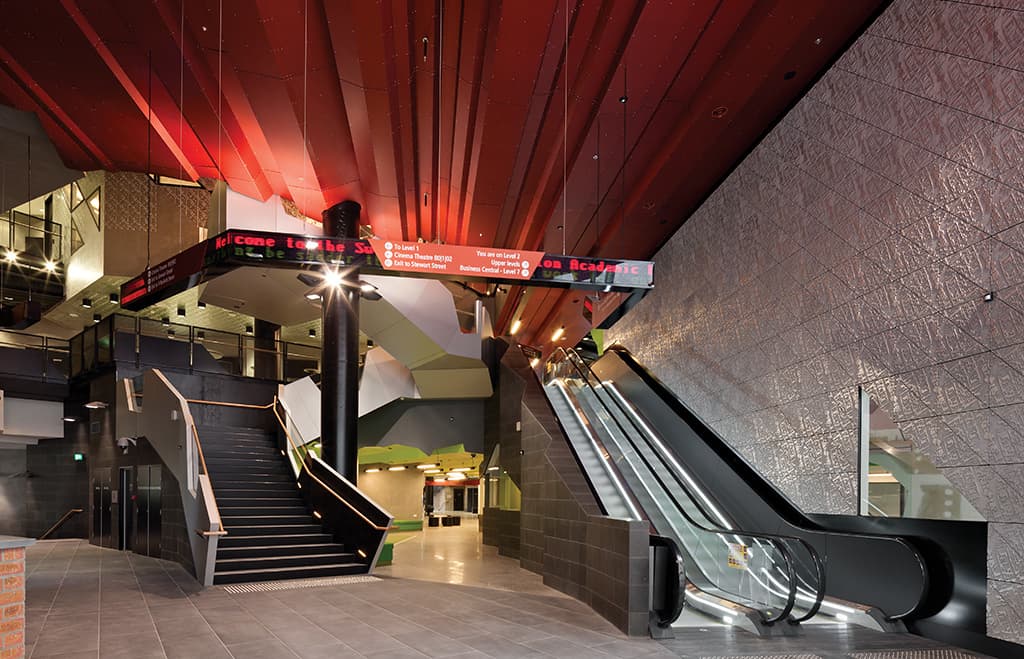
IN CONTROL
The AV control systems are AMX (mostly seven-inch Modero touch panels with large ELO touch panels and TPI Pros in the bigger rooms); however the switching is all Crestron Digital Media. An AMX Room Management System watches over all of the AV systems, providing monitoring and warning of any equipment failures.
Where possible, all equipment control is implemented over IP rather than by RS-232. McFadden plans to make this the standard into the future and told me that the new building required around 2100 IP addresses in the AV system alone. “It was quite a change,” he said. “Prior to the SAB we only had about 2000 AV-related IP addresses across the whole university. This building doubled that at one stroke.”
A showcase room is the fully kitted-out 180-seat cinema, which McFadden noted is used for Cinema Studies courses. As well as a pair of Mitsubishi WD8200U WXGA projectors for standard teaching, a Panasonic PJ-DZ1200E 12,000 ANSI lumen full HD projector lurks in the projection booth for movie presentations. Celluloid is also fully catered for with two Kinoton 35mm film projectors packing 2kW lamp-houses. One of the projectors is dual gauge, allowing 16mm film presentation as well. There is a full motorised drape system up front so the screen can be masked to the correct aspect ratio for different cinema formats. “We all had to do a conversion course to get up to speed on sprockets,” McFadden commented wryly. “Luckily, one of the guys here on site is a fully-qualified cinema projectionist and he just loves operating in there.”
Naturally, audio hasn’t been forgotten and the cinema has been designed to conform to THX specifications should RMIT decide to opt for certification. A Dolby CP6500X processor handles decoding of movie soundtracks and feeds purpose-built Electro-Voice cinema-grade power amplifiers and speaker systems configurable for up to 9.2 channel sound. Naturally, the front EV speakers sit discreetly behind the perforated screen.
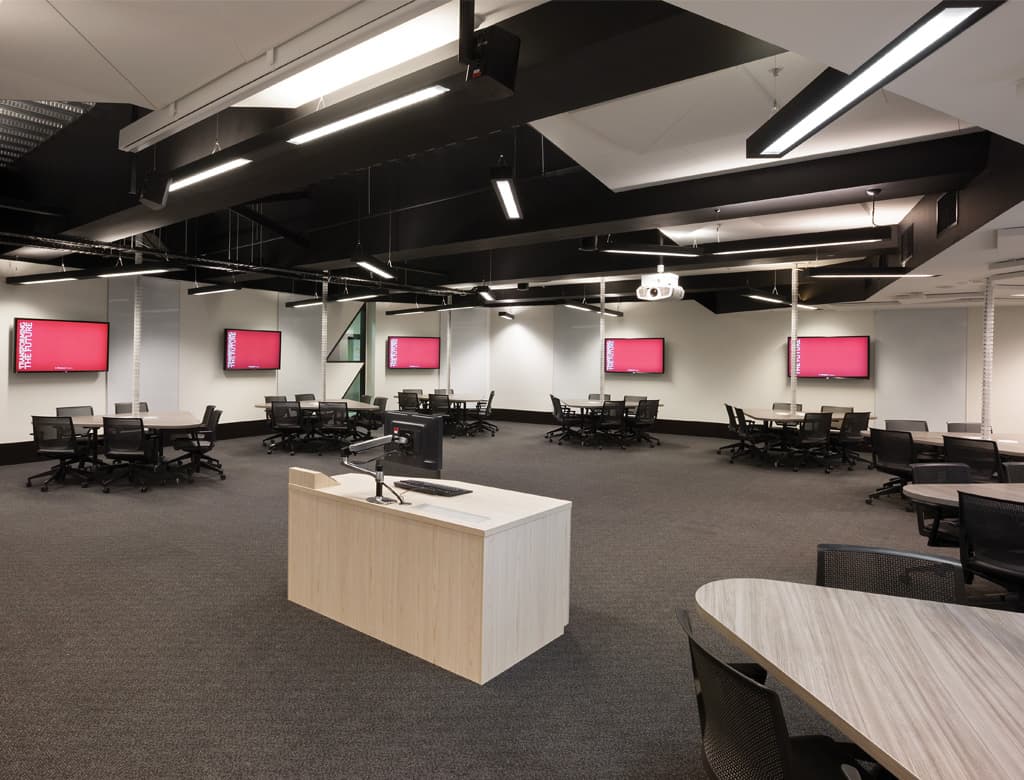
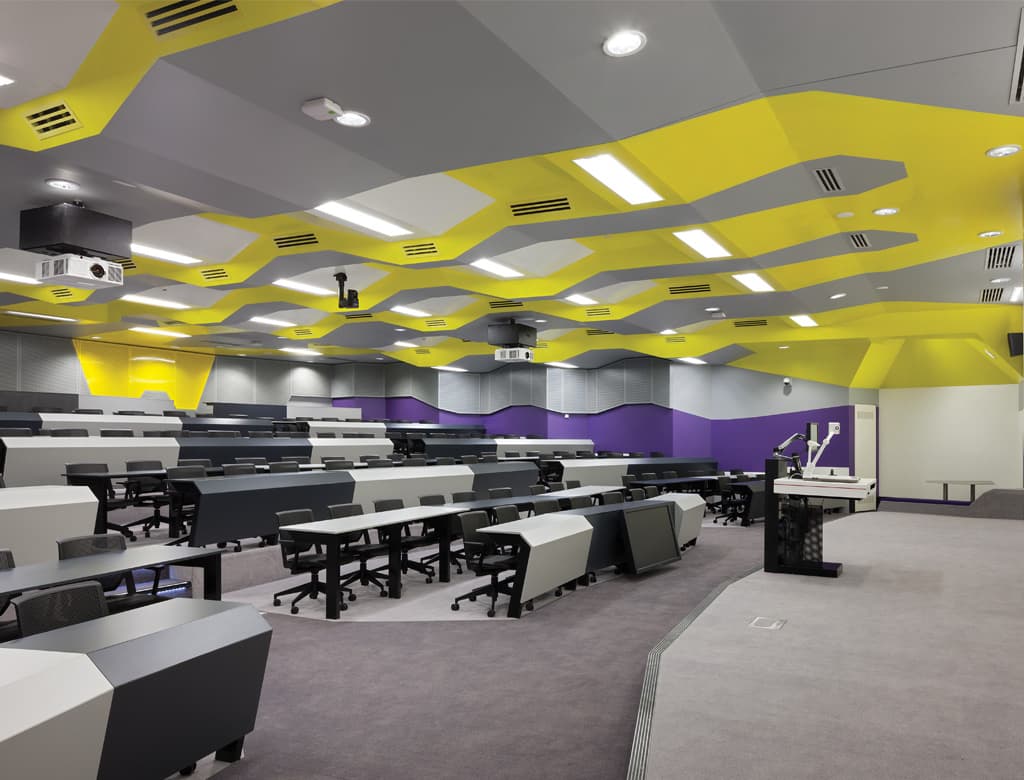
COLLABORATIVE CLASSROOMS
“Apart from the main lecture theatres and cinema, there are very few traditional ‘face-the-front’ classrooms,” McFadden explained. “Most of the teaching is based around student collaboration, with a lot of six-seat tables in the smaller rooms.”
Display in these collaborative classrooms is managed by a combination of AV and IT techniques. We are now firmly in the era of BYOD (bring your own device) computing and there are no PCs provided for student use in the teaching rooms. Instead, students participate by logging in from their own laptops, tablets or i-devices to their university ‘virtual desktop’. Once there, they can use TeamSpot software to connect wirelessly to each other or to the lecturer’s PC at the front of the room. With the matching ClassSpot software, the academic can then choose to take output from any student’s machine and display it on the projector.
In the ‘project rooms’, each six-seat group table has access via TeamSpot to an adjacent wall mounted 55‑inch (1.4m) LCD monitor. For teacher-led sessions, the academic’s PC is connected directly to all monitors. To further simplify the audiovisual switching in these rooms, an Epson DC11 document camera is connected via USB to the house PC at the lecturer’s station. To show the camera, the academic simply uses software to display the camera on the PC output. The classrooms also feature lots of writable surfaces and a number include TeamBoard 87-inch (2.2m) interactive whiteboards.
DIGITAL SIGNAGE
Spread throughout the building are more than 90 digital signage displays based on the NEC Live platform. As well as the more conventional large LCD information displays, there are a couple of special interactive implementations. In the SAB, academics don’t have individual offices; there are open-plan spaces on several of the floors. These spaces are secured using access cards so at each office area entrance, there is a 22-inch (560mm) NEC touchscreen display that allows visitors and students to search the phone number of the person they wish to visit. Outside the large lecture theatres, a similar-sized monitor shows the timetable for that room – very handy when literally thousands of students attend classes in the theatres each day. Finally, in the foyer, there is a scrolling LED ‘ticker’ display that runs 23 metres around the atrium walls.
RMIT University has certainly made a powerful statement from the outside with the striking architecture of the SAB building, but with around seven and a half million dollars of audiovisual fit-out, the interior speaks equally powerfully about their commitment to the student experience.
MORE INFORMATION
TeamSpot and ClassSpot:
Tidebreak Software
www.tidebreak.com
Kinoton Cine Projectors:
www.kinoton.de/en/home.html
Epson DC11 Document Camera:
www.epson.com.au/products/ProjectorAccessories/ELP-DC11.asp
NEC Live Signage:
au.nec.com/en_AU/solutions/display-solutions/digital-signage/nec-live-overview.html
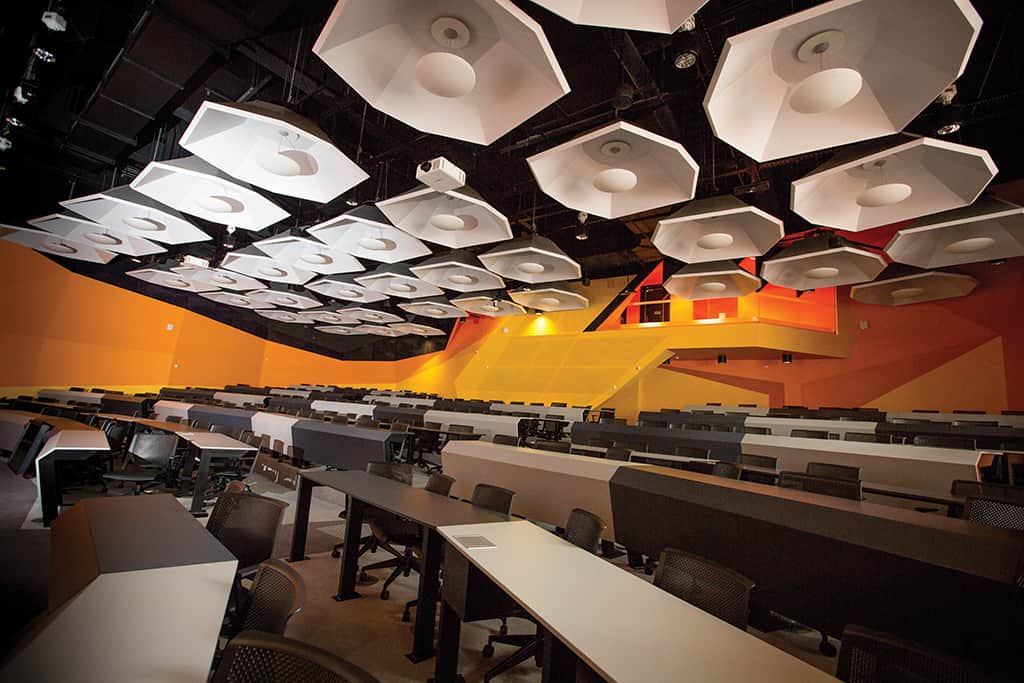
EQUIPMENT HIGHLIGHTS
PROJECTION
Data Projectors:
Panasonic PT-DZ-1200E
Mitsubishi WD 8200U
Projector lift:
Ultralift PRT-32-5
Film projectors:
Kinoton FP30E
Kinoton FP38E
SOURCE EQUIPMENT
Document camera:
Elmo P30S
Video player:
LG GC980W
CONTROL & SWITCHING
Control system:
AMX NI 4100 Netlinx controller
NI-900 Netlinx controller
MVP-9000i-TCS wireless touchpanel
TPI-PRO2-DVI presentation interface
ELO Touch 1900L touchscreen
Switching:
Crestron: DMMD16X16 DigitalMedia 16×16 matrix frame
Crestron DigitalMedia – fibre transmitter 201
Crestron DigitalMedia fibre receiver & room controller
DMCHD HDMI input card
DMCS fibre input card
DMCO4400 4 x fibre w/ 2 x HDMI output card
RECORDING
Echo360 lecture capturing device
AUDIO
Microphones:
AKG SR450 receiver
CU400 dual handheld/belt pack charging station
WMS450HTC handheld diversity wireless microphone
Revolabs HD-Mic-Wear HD wearable wireless microphone
HD-Venue HD wireless receiver – 2-channel
DSP:
Biamp Nexia-CS
Dolby Processor Dolby CP650OX Dolby cinema audio processor
Amplifiers:
Electrovoice CPS 2.4; CPS 2.6; CPS 2.9; CPS 2.12 stereo amplifiers
Loop Amps:
Ampetronic ILD1000G; SP5
Speakers:
Electrovoice VariPlex-M cinema LCR speaker
TL440 cinema sub speaker
SL10-2V cinema surround speaker
Australian Monitor AM20CS 2-way premium ceiling speaker





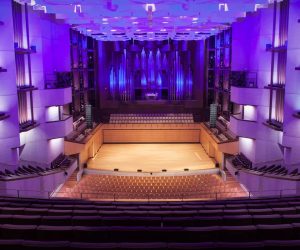









RESPONSES